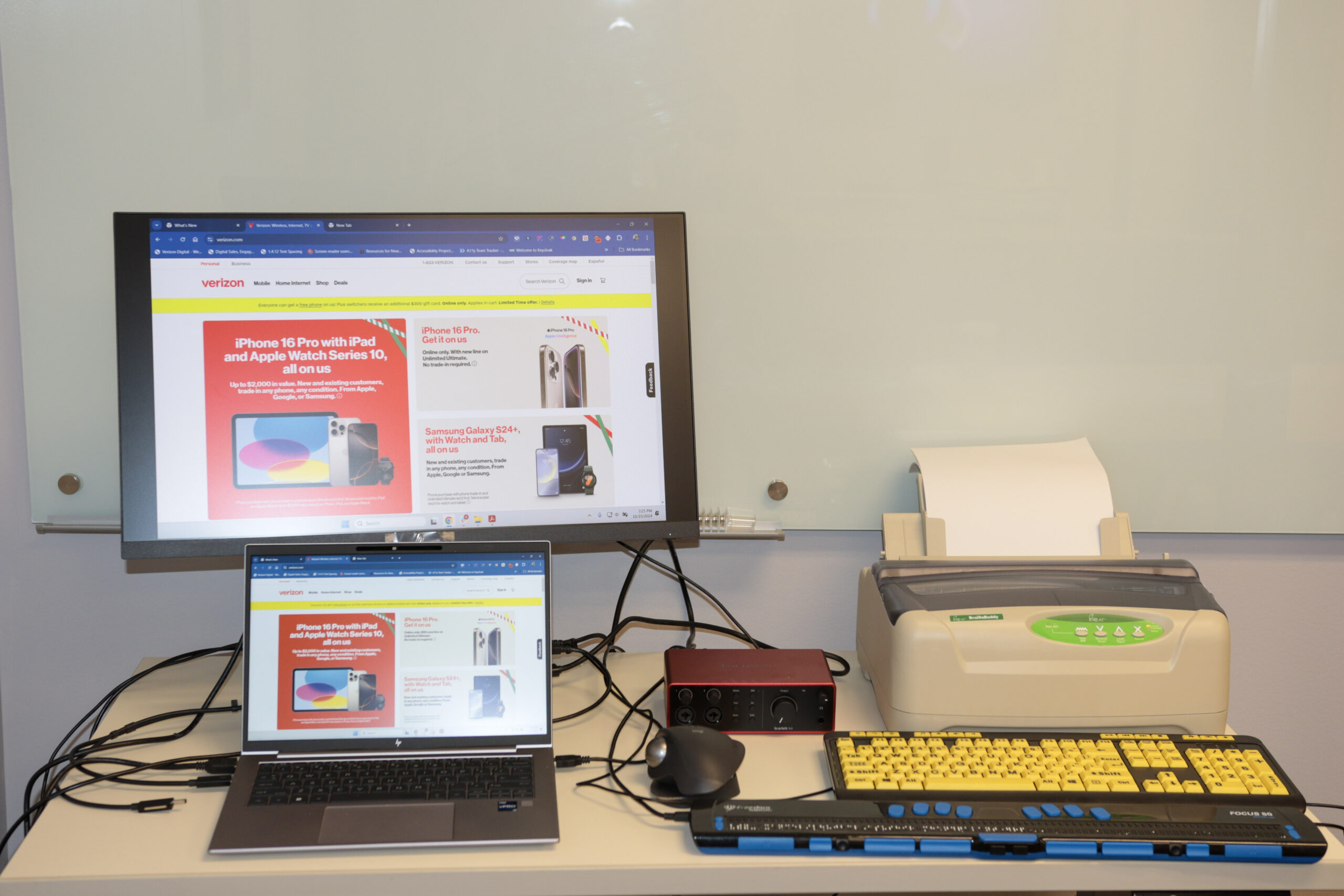Summary

This article is based on Fred Moltz’s talk at A11yNYC.
Nine years ago, Fred Moltz started Verizon’s accessibility program. He built it from the ground up, which helped him evolve into a disability advocate and champion.
When Fred started his accessibility journey, he did not have a disability. Then, five years ago, he was in a bad car accident. As a result, he lost all the nerve feelings in his fingers and left leg from the knee down.
Verizon’s Accessibility Journey
When Fred joined the Verizon accessibility team, he had a team of one employee and two contractors. One of those contractors, Sushil, is now an employee and a big reason for the program’s success.
They were tasked with looking at the company’s homepage and making it accessible. They started there. The team evolved from just having a homepage to expanding accessibility across the enterprise to include employees and customers. Customers refer to customer-facing systems, websites, mobile apps, and retail experience.
It’s one thing to worry about your customers. But you’ve got to take care of the employees creating the innovative products customers expect. The team took a holistic view of accessibility. There was no playbook. There was no blueprint. There was no road map. They just dug in.
They built things from the ground up. They created a playbook, processes, and procedures so they could be repeatable and inclusive. The scope continued to change as they made progress. It wasn’t just about compliance and making sure they were WCAG compliant. It was also about moving beyond compliance.
Compliance is just table stakes. They’re not perfect at it, but they always strive to do better. It’s a matter of looking at WCAG and how to take it and build it better. The better you make a product or service for people with disabilities, the better it is for everyone. And that’s the message that we’re always trying to share with people, inside Verizon and outside of Verizon.
They’re also working on some of the societal programs and efforts at Verizon. Verizon’s accessibility program is one team in the ecosystem. It takes a village. It’s not just the office of accessibility that Fred oversees. The team collaborates with a lot of teams like their strategic alliance partners, their corporate social responsibility team, IT teams, design teams, and design system teams.
In partnering with teams, they explore what they can do to further the mission. For example, two years ago, the corporate social responsibility team came out with a program called Four For Good. It’s an accelerator program where they took seven startup companies and seeded them with money. They also provided guidance and networking to help build out their products and services. Because it was just the right thing to do.
They sponsored the Disability Collection with Getty Images to create a collection of images that portray people with disabilities authentically. The company also created a Verizon Disability Advisory Board. It contains ten individuals from ten different disability advocacy groups and organizations to ensure the company applies the “Nothing about us without us” mantra.
Helping Employees Make Connections with Accessibility
The company’s rallying cry is “We power and empower how people live, work, and play.” It’s important because it’s Verizon and they’re a lot of different things. They are a network that’s about access to entertainment and communications. They have perks and partnerships with different organizations and teams.
Verizon provides a network, the right devices, and the right mobile apps to allow people to live, work, and play everywhere and always. That turns into providing accessible experiences and solutions that allow independence that everyone expects and deserves. They’re ensuring that the assistive technology that people use works with their products, services, networks, and platforms.
One of the other things from a societal perspective is the two events that Verizon hosts every year. One is the annual Global Accessibility Awareness Day (GAAD) celebration. It’s a big event at Verizon as it’s an opportunity that’s part of their education and awareness pillar.
The purpose of the event is to promote accessibility. They reach people who may not have been exposed to accessibility. They cover what it’s about, why it’s important, why it’s a legal requirement, and that it’s the right thing to do. Verizon has leaders in different teams across the enterprise who believe it is the right thing to do.
The other event is the annual accessibility tech expo and summit, which is an internal event. Day one is a half-day event where they bring in different partners from assistive technology companies, consulting groups, and advocacy groups, to headquarters in New Jersey. The company sets up booths for them right outside the cafeteria to ensure they get the lunch traffic.
They showcase different assistive technologies that people use. The hope is that people will come to the expo having no idea what accessibility is. They end up making connections because somebody in their family or one of their friends may use the technology. The second day is a full-day event where they bring in leaders from every major organization at Verizon talking about how their team supported the accessibility program throughout the year.
They do this because employees want to hear from their leaders. When they see their leader at an accessibility summit, they want to know why. So, they show up in person or they dial in and they watch it. They hear how their leader and their work benefit customers and employees with disabilities. It’s the best way of connecting the dots and sharing the message of why accessibility is so important for everybody and everything they do daily.
Verizon’s Technology and Innovation Lab
This year’s GAAD was special for Verizon because they opened their Accessibility Technology and Innovation Lab. They took a lot of time planning this to ensure they did it right including the ribbon-cutting ceremony. At the ceremony, they brought in the right leaders who talked about why the lab was important to the company, customers, employees, and society at large.
This is not your typical lab that you would see at some high-tech company, where it’s all about space-looking gadgets. They took a different approach. Their space is not the high-powered tech space that you may have seen with other labs. They wanted to create a safe and accommodating space that was open to everyone where they felt welcomed and willing to share.
A big part of the lab space is the testing, both automated and manual. They test websites, mobile apps, devices, and Fios set-top boxes. They go beyond testing as they also focus on the experience. For example, they’ll test an Alexa device experience with Verizon’s set-top box. It’s important to do this to help people who don’t have a disability understand these experiences are everyday life for someone with a disability.
They want everyone to come into the lab. It’s an opportunity to listen to customers and employees. The company wants to know what’s working well and what’s not working well. While something may be compliant, it doesn’t mean it’s a good experience. The lab allows the company to dive into the experiences of individuals with disabilities and how they’re using their devices on the network.
Think about any phone that you can find on the company website. They test all those phones. The team also looks at the different operating models that those phones leverage because there are different experiences based on the operating system. Is it iOS? Android? What version of it?
Verizon has nine different home pages. Those are important because it’s their digital front door to the world. They test these home pages, for example, every single morning. They want to ensure everyone who comes in has a great experience just as they would a physical store.
Besides, things break overnight. Their goal is to test those home pages and make sure they find any problems before users do. It’s embarrassing when somebody else finds it before you do.
Verizon has 40-plus branded apps out. Those provide different touchpoints for their customers, potential customers, and their employees. So they’re testing those all the time. And it’s about the experiences.
The lab is in Freehold, New Jersey, which is in the middle of New Jersey. And it’s where Bruce Springsteen grew up. The space is next to a hospital, a mall, and a lot of different places. It’s easier to get into the building. It takes about an hour and 15 minutes to drive from New York City or Philadelphia to Freehold. It’s about an hour from Newark Airport.
Lab Experience
The lab has three main sections: home, collaboration, and education.
Home
When you first enter the lab, they have a Home section. What does that mean? Think about your home. Think about your living room. You may have a couch, a TV, and maybe an entertainment center with a set-top box, cable, Apple TV device, Xbox, Alexa, or a combination. The lab has all of these in its home section.

This idea is for you to come in and sit on the couch, turn on the Fios TV, and show them how you use the service. If you don’t have Fios, then they’ll showcase it to you. They want to know what you like and compare it. For instance, they’d ask you to show them how you’re using your Apple TV on the Fios network.
After you’re done looking at TVs and set-top boxes, they may ask you to pull out your phone. They want to see how you’re using the phone. They’ll stream the phone to their big TV. They’ll encourage you to browse on your phone, flip through social networks, and whatever websites you use on your phone. They want to understand how you’re doing it.

Collaboration
The Collaboration section gets more into the operational aspect of accessibility at Verizon. The section contains a big conference room table with about 10 chairs around it. They have this set up to help them find and remediate defects. They also have two desktops, one runs Windows and the other is a Mac. Both have individual Braille displays, which are key to understanding experiences. They also have a Braille printer and big whiteboards. The hope is to create a safe space for collaboration and innovation.
The Collaboration area contains Verizon retail point-of-sale systems and care systems. They’re both in production. They want to do live testing to understand what’s going on from a system rep’s perspective. They also have the environment on the tablets from a point-of-sale perspective.
The collaboration area is also the place to look at new things that are launching. The collaboration space allows people to sit together and go through those experiences. They check for compliance as well as going beyond compliance.

Education
The lab contains a space where they hold all the education and awareness events. They also host public speaking engagements, webinars, lectures, and live demos.
The Education section has a podium used primarily for training internal Verizon team members. They tailor training for the development team, retail team, and anyone who needs training on accessibility. The more people understand the impacts accessibility has on the world; the more Verizon will build more innovative products that benefit everybody.
Verizon’s accessibility program is built on three main pillars:
- Educational awareness
- Compliance
- Beyond compliance
All these supports shifting left and including these projects and initiatives from the beginning. They bring all these devices and different things into this lab for testing. There are times when someone asks, “Hey, do you have this?” and they won’t know what it is and ask about it. They’ll do whatever they can to get the technology into the lab and test its experiences.
What Else to Know about the Verizon Accessibility Lab
They purposefully did not go over the top with the lab. They want it to feel like the place each area represents. They want it to feel like a real living room or conference space.
They have an accessibility atrium that has a large “Verizon accessibility” sign.
When you enter the accessibility atrium at Verizon, there are big signs saying “Verizon accessibility.” The signs aren’t just there. They also appear as you go down the hallway to the lab. Everything says accessibility.
They took it to another level and put a big 75-inch TV in the middle of it. It constantly plays videos of different accessibility speakers and advocates. It also has their own videos of things that they’ve done. The point is that anyone inside Freehold will know accessibility is real.
Throughout the lab are pictures of people with disabilities. Some of those pictures are from the Getty Images Disability Collection. Some of those pictures are of Verizon team members with disabilities. It’s a way to show that this isn’t for show. This is a working lab.
The lab is open to everybody, especially customers and employees. They want feedback from their customers. Their employees are a big piece of the research and testing. Without employees, they’re nothing. It’s nothing about us without us.
Assistive technology startup companies and people who have been in the assistive tech world for a long time also come to the lab. Companies can share their technologies. Verizon will connect it to its network and products. They’ll bring in disabled people to play with the company’s technologies and websites to show how the experience is for someone with a disability.

At the end of the day, building a more inclusive world takes people, processes, and technology to go beyond compliance. “I ask everybody … I want everybody to dream bigger. I want you to dream the impossible. And together — let’s all make it possible together,” says Fred Moltz.
If you’d like to visit the lab, contact fred.moltz@verizon.com.
Video Highlights
- Verizon accessibility journey
- Accessibility technology and innovation lab
- Lab experience
- Who is lab open to?
- Q&A with Fred Moltz
Watch the Presentation
Bio
Fred Moltz is the Chief Accessibility Officer at Verizon. Fred’s experience includes over 24 years at Verizon in multiple strategic and leadership roles, including the last nine years of building Verizon’s Accessibility Program from the ground up.
Fred’s mission is to provide continued leadership that incorporates Accessibility by Design in all aspects of Verizon that will provide exceptional experiences for all employees and customers. Fred and his team work daily to engage everyone and reimagine accessibility. In addition to his daily responsibilities, Fred serves on the Board for Disability Rights New Jersey.